人教版七年级上册 Unit 4 Where’s my schoolbag?Section A 1a-2d课件(共26张PPT,内嵌音频)
文档属性
| 名称 | 人教版七年级上册 Unit 4 Where’s my schoolbag?Section A 1a-2d课件(共26张PPT,内嵌音频) | 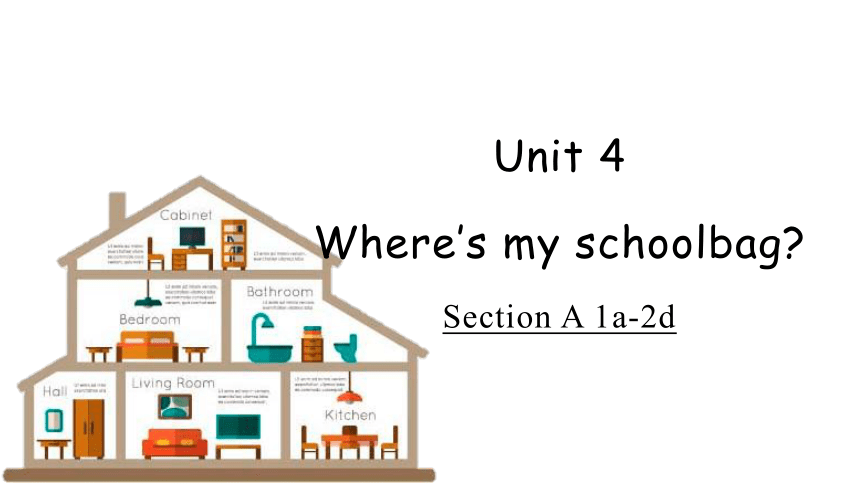 | |
| 格式 | pptx | ||
| 文件大小 | 6.8MB | ||
| 资源类型 | 教案 | ||
| 版本资源 | 人教新目标(Go for it)版 | ||
| 科目 | 英语 | ||
| 更新时间 | 2023-06-09 13:04:37 | ||
图片预览

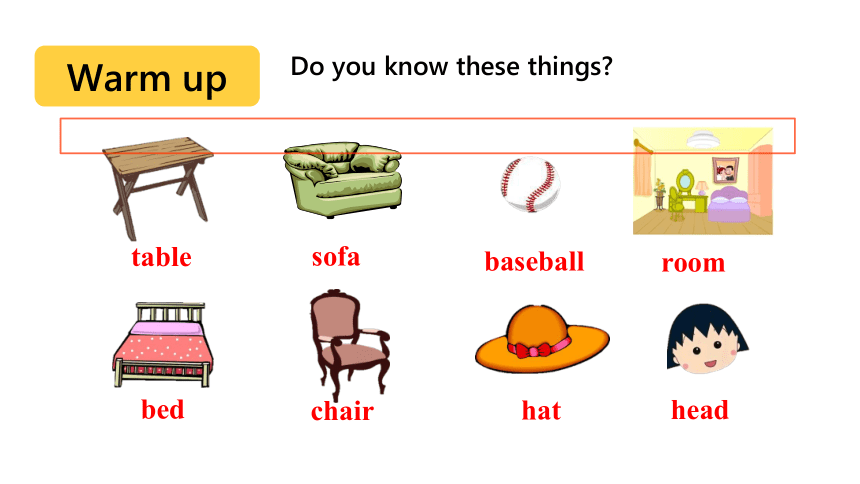
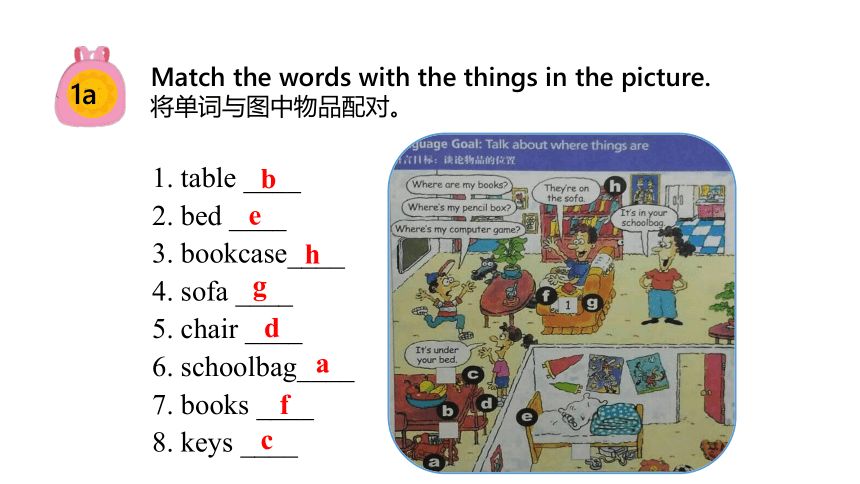
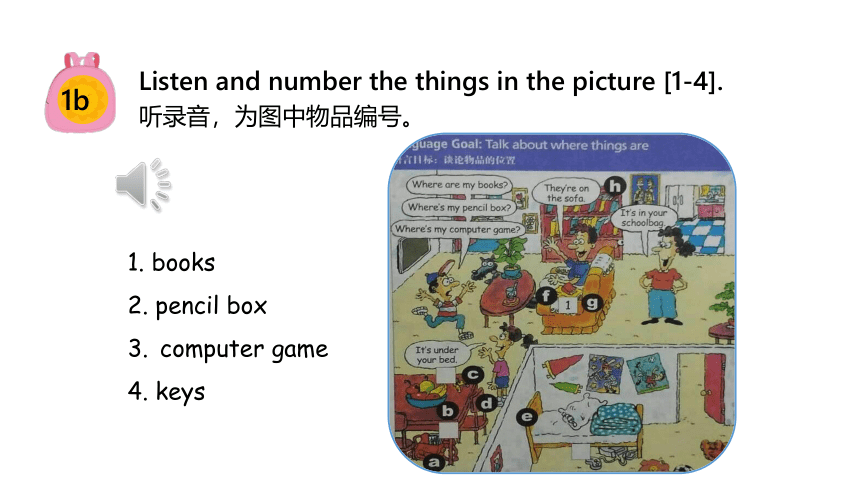
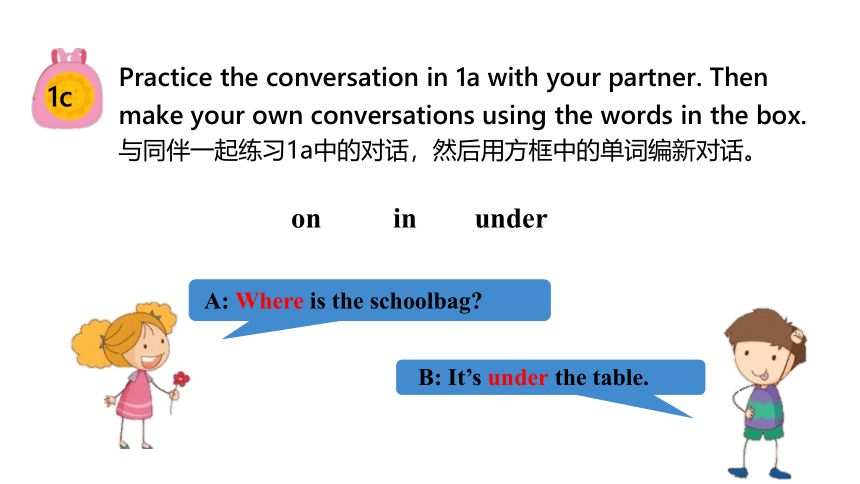
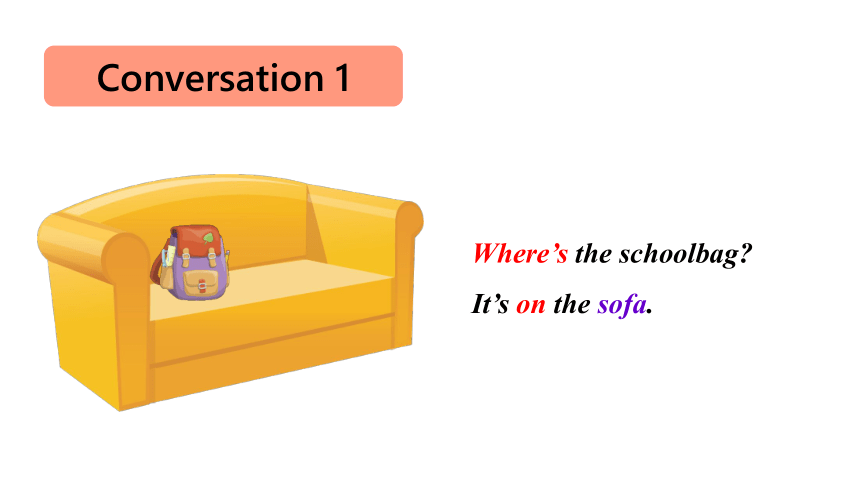
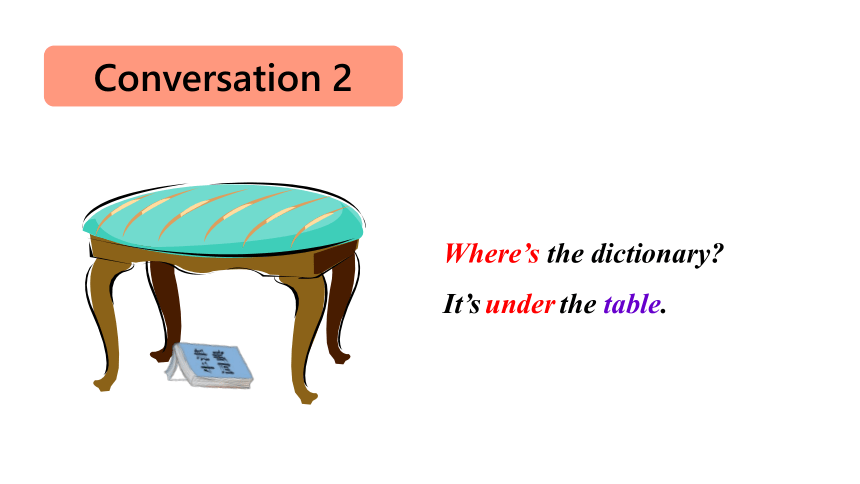
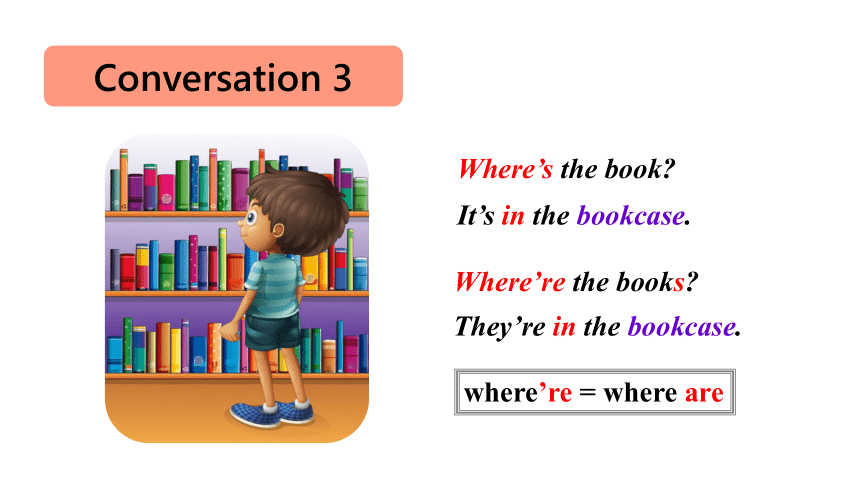
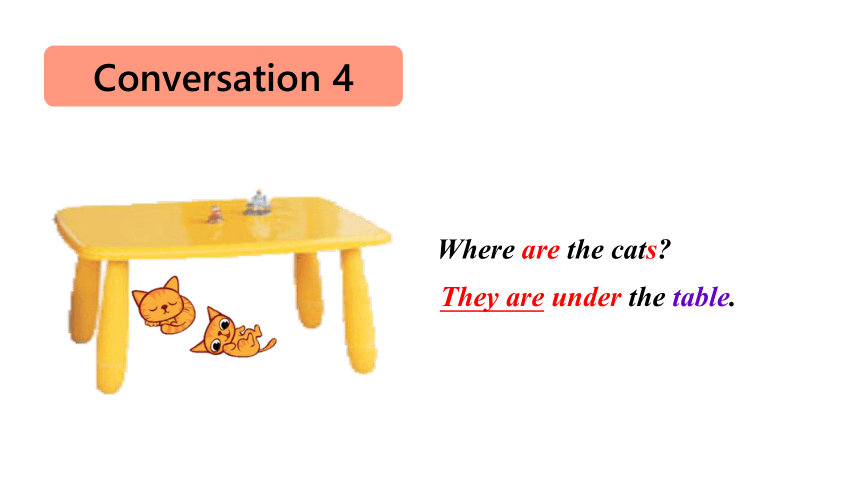
文档简介
(共26张PPT)
Unit 4
Where’s my schoolbag
Section A 1a-2d
head
hat
baseball
chair
bed
sofa
table
room
Warm up
Do you know these things
1a
1. table ____
2. bed ____
3. bookcase____
4. sofa ____
5. chair ____
6. schoolbag____
7. books ____
8. keys ____
b
e
h
g
d
a
f
c
Match the words with the things in the picture.
将单词与图中物品配对。
1b
Listen and number the things in the picture [1-4].
听录音,为图中物品编号。
1. books
2. pencil box
computer game
4. keys
1c
Practice the conversation in 1a with your partner. Then make your own conversations using the words in the box.
与同伴一起练习1a中的对话,然后用方框中的单词编新对话。
on in under
A: Where is the schoolbag
B: It’s under the table.
Conversation 1
Where’s the schoolbag
It’s on the sofa.
It’s the table.
under
Where’s the dictionary
Conversation 2
Where’s the book
It’s in the bookcase.
Where’re the books
They’re in the bookcase.
where’re = where are
Conversation 3
Where are the cats
They are under the table.
Conversation 4
Where’re the baseballs
They’re on the chair.
Conversation 5
Practice 1
A: Where’s the …
B: It’s …
A: Where’s the pencil
B: It’s in the pencil box.
…
…
…
…
…
…
Practice 2
A: Where are the …
B: They’re …
A: Where are the keys
B: They are on the table.
…
2a
Listen and number the things [1-6].
听录音,为物品编号。
2
3
4
5
6
2b
Listen again. Find the things from 2a and number them in the picture [1-6].
再听一遍录音,找出2a中的物品并编号。
2
3
4
5
6
1
2c
2
3
4
5
6
1
2
3
4
5
6
A: Are the keys on the
sofa
B: No, they aren’t.
They’re on the table.
Ask and answer questions about the things in the picture in 2b.
就2b图中物品的位置与同伴问答。
2d
Role-play the conversation. 分角色表演对话。
Mom: Come on, Jack!
Jack: Oh, no! Where’s my bag
Mom: Hmm … is it on your desk
Jack: No. And it’s not under the chair.
Mom: Oh! It’s on the sofa.
Jack: Thank you, Mom. Err … where’s the map
Mom: I think it’s in your grandparents’ room.
Jack: Yes, it’s on their bed! And my hat
Mom: It’s on your head!
Jack: Oh, yeah! Haha!
Explanation
一、where引导的特殊疑问句
1. 用法:询问人或物所在的位置,其结构为“Where is+单数名词 ?”或“Where are+复数名词?”。where后面的be动词取决于后面的名词或代词的单复数形式。单数用is,复数用are。
e.g. Where is my eraser?我的橡皮在哪儿?
Where are your keys?你的钥匙在哪儿?
2. 答语:
①用 It’s+介词短语(对应Where is...?)或 They’re+介词短语
(对应Where are...?)。
e.g. (1)—Where is my eraser
—It's on the desk.
(2)—Where are your keys
—They are on the sofa.
②可直接回答物品所在地点,省略it’s或they’re。
二、介词in, on与under的用法
1. in意为“在……里面,在……内”,通常表示在某一空间里。
2. on意为“在……上面”,表示物体间上下面的直接接触。
3. under意为“在……下面”。
in
on
under
三、come on的用法
1. 意为“快点儿”,表示催促某人做某事。
e.g. Come on. It’s time to go to school! 快点儿,到上学的时间了!
2.用于鼓励他人,意为“加油”。
e.g. Come on! You’ll get good grades. 加油!你会取得好成绩。
3.表示请求、劝说等,意为“来吧;好啦”等。
e.g. Come on. Don’t cry. 好啦,不要哭了。
4.用于招呼他人,意为“过来;来”。
e.g. Come on! This way, please. 过来!请走这边。
四、否定前移
1. I think意为“我认为”,用来表述自己的主观想法或看法,其后常跟that引导的从句作宾语,即宾语从句。口语中常常省略that。
e.g. I think (that) you are right. 我认为你是对的。
2. 当主句的谓语动词为think,其后接宾语从句时,若宾语从句表示否定意义,在形式上应该否定前面的主句,这种现象叫“否定前移”。
【注意】
(译)我认为他不是一名教师。
(误)I think he isn’t a teacher.
(正)I don’t think he is a teacher.
五、省略句
“And my hat 那我的帽子呢?”这是一个省略句,其完整形式为“And where is my hat ”。在英语口语中,根据语境,在不会引起歧义的情况下,可省去与上文相同的内容,用 and来连接,使语言简洁明了。
e.g. —Where’s your school ID card, Jane
你的学生证在哪儿,简?
—It’s on the chair. 它在椅子上。
—And your dictionary 那你的字典呢?
—On the desk. 在书桌上。
Game
Memory challenge
记忆挑战
A: Where is/are the …
B: It’s/ They’re …
In picture A, …
is/are on/in/under…
In picture B…
A
B
Game
There are five differences
in the two pictures. Can you find them
两幅图中有五处不同。你能找出它们吗?
Exercise
填入适当的词完成对话或句子。
1. A: _________ my book
B: It’s on the desk.
2. A: _________my pencils
B: They’re ________ (在······下) your bed.
3. A: ________the keys
B: They’re on the _________(书架).
4. My ______ _______(飞机模型 ) is under the sofa.
5. My __________(字典) and _________( 收音机) are on the desk.
Where’s
Where’re
under
Where’re
bookcase
model plane
dictionary
radio
Homework
1. Remember the words and language points in this class.
2. Draw your own room and write the things in your room.
Unit 4
Where’s my schoolbag
Section A 1a-2d
head
hat
baseball
chair
bed
sofa
table
room
Warm up
Do you know these things
1a
1. table ____
2. bed ____
3. bookcase____
4. sofa ____
5. chair ____
6. schoolbag____
7. books ____
8. keys ____
b
e
h
g
d
a
f
c
Match the words with the things in the picture.
将单词与图中物品配对。
1b
Listen and number the things in the picture [1-4].
听录音,为图中物品编号。
1. books
2. pencil box
computer game
4. keys
1c
Practice the conversation in 1a with your partner. Then make your own conversations using the words in the box.
与同伴一起练习1a中的对话,然后用方框中的单词编新对话。
on in under
A: Where is the schoolbag
B: It’s under the table.
Conversation 1
Where’s the schoolbag
It’s on the sofa.
It’s the table.
under
Where’s the dictionary
Conversation 2
Where’s the book
It’s in the bookcase.
Where’re the books
They’re in the bookcase.
where’re = where are
Conversation 3
Where are the cats
They are under the table.
Conversation 4
Where’re the baseballs
They’re on the chair.
Conversation 5
Practice 1
A: Where’s the …
B: It’s …
A: Where’s the pencil
B: It’s in the pencil box.
…
…
…
…
…
…
Practice 2
A: Where are the …
B: They’re …
A: Where are the keys
B: They are on the table.
…
2a
Listen and number the things [1-6].
听录音,为物品编号。
2
3
4
5
6
2b
Listen again. Find the things from 2a and number them in the picture [1-6].
再听一遍录音,找出2a中的物品并编号。
2
3
4
5
6
1
2c
2
3
4
5
6
1
2
3
4
5
6
A: Are the keys on the
sofa
B: No, they aren’t.
They’re on the table.
Ask and answer questions about the things in the picture in 2b.
就2b图中物品的位置与同伴问答。
2d
Role-play the conversation. 分角色表演对话。
Mom: Come on, Jack!
Jack: Oh, no! Where’s my bag
Mom: Hmm … is it on your desk
Jack: No. And it’s not under the chair.
Mom: Oh! It’s on the sofa.
Jack: Thank you, Mom. Err … where’s the map
Mom: I think it’s in your grandparents’ room.
Jack: Yes, it’s on their bed! And my hat
Mom: It’s on your head!
Jack: Oh, yeah! Haha!
Explanation
一、where引导的特殊疑问句
1. 用法:询问人或物所在的位置,其结构为“Where is+单数名词 ?”或“Where are+复数名词?”。where后面的be动词取决于后面的名词或代词的单复数形式。单数用is,复数用are。
e.g. Where is my eraser?我的橡皮在哪儿?
Where are your keys?你的钥匙在哪儿?
2. 答语:
①用 It’s+介词短语(对应Where is...?)或 They’re+介词短语
(对应Where are...?)。
e.g. (1)—Where is my eraser
—It's on the desk.
(2)—Where are your keys
—They are on the sofa.
②可直接回答物品所在地点,省略it’s或they’re。
二、介词in, on与under的用法
1. in意为“在……里面,在……内”,通常表示在某一空间里。
2. on意为“在……上面”,表示物体间上下面的直接接触。
3. under意为“在……下面”。
in
on
under
三、come on的用法
1. 意为“快点儿”,表示催促某人做某事。
e.g. Come on. It’s time to go to school! 快点儿,到上学的时间了!
2.用于鼓励他人,意为“加油”。
e.g. Come on! You’ll get good grades. 加油!你会取得好成绩。
3.表示请求、劝说等,意为“来吧;好啦”等。
e.g. Come on. Don’t cry. 好啦,不要哭了。
4.用于招呼他人,意为“过来;来”。
e.g. Come on! This way, please. 过来!请走这边。
四、否定前移
1. I think意为“我认为”,用来表述自己的主观想法或看法,其后常跟that引导的从句作宾语,即宾语从句。口语中常常省略that。
e.g. I think (that) you are right. 我认为你是对的。
2. 当主句的谓语动词为think,其后接宾语从句时,若宾语从句表示否定意义,在形式上应该否定前面的主句,这种现象叫“否定前移”。
【注意】
(译)我认为他不是一名教师。
(误)I think he isn’t a teacher.
(正)I don’t think he is a teacher.
五、省略句
“And my hat 那我的帽子呢?”这是一个省略句,其完整形式为“And where is my hat ”。在英语口语中,根据语境,在不会引起歧义的情况下,可省去与上文相同的内容,用 and来连接,使语言简洁明了。
e.g. —Where’s your school ID card, Jane
你的学生证在哪儿,简?
—It’s on the chair. 它在椅子上。
—And your dictionary 那你的字典呢?
—On the desk. 在书桌上。
Game
Memory challenge
记忆挑战
A: Where is/are the …
B: It’s/ They’re …
In picture A, …
is/are on/in/under…
In picture B…
A
B
Game
There are five differences
in the two pictures. Can you find them
两幅图中有五处不同。你能找出它们吗?
Exercise
填入适当的词完成对话或句子。
1. A: _________ my book
B: It’s on the desk.
2. A: _________my pencils
B: They’re ________ (在······下) your bed.
3. A: ________the keys
B: They’re on the _________(书架).
4. My ______ _______(飞机模型 ) is under the sofa.
5. My __________(字典) and _________( 收音机) are on the desk.
Where’s
Where’re
under
Where’re
bookcase
model plane
dictionary
radio
Homework
1. Remember the words and language points in this class.
2. Draw your own room and write the things in your room.
同课章节目录
- starters 预备篇(2012秋审查)
- Unit 1 Good morning !
- Unit 2 What’s this in English?
- Unit 3 What color is it ?
- Unit 1 My name's Gina.
- Section A
- Section B
- Unit 2 This is my sister.
- Section A
- Section B
- Unit 3 Is this your pencil?
- Section A
- Section B
- Unit 4 Where's my schoolbag?
- Section A
- Section B
- Unit 5 Do you have a soccer ball?
- Section A
- Section B
- Unit 6 Do you like bananas?
- Section A
- Section B
- Unit 7 How much are these socks?
- Section A
- Section B
- Unit 8 When is your birthday?
- Section A
- Section B
- Unit 9 My favorite subject is science.
- Section A
- Section B
